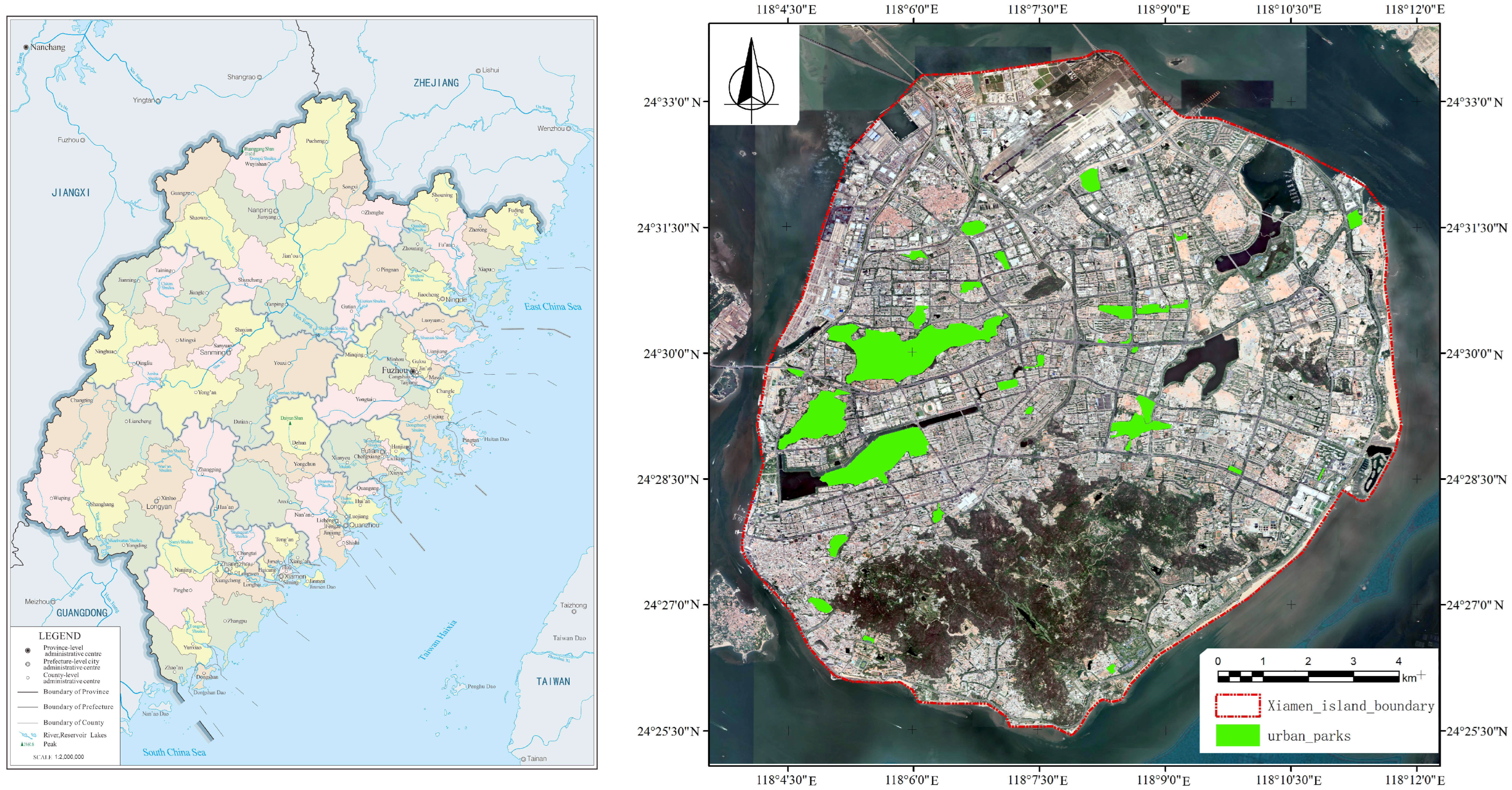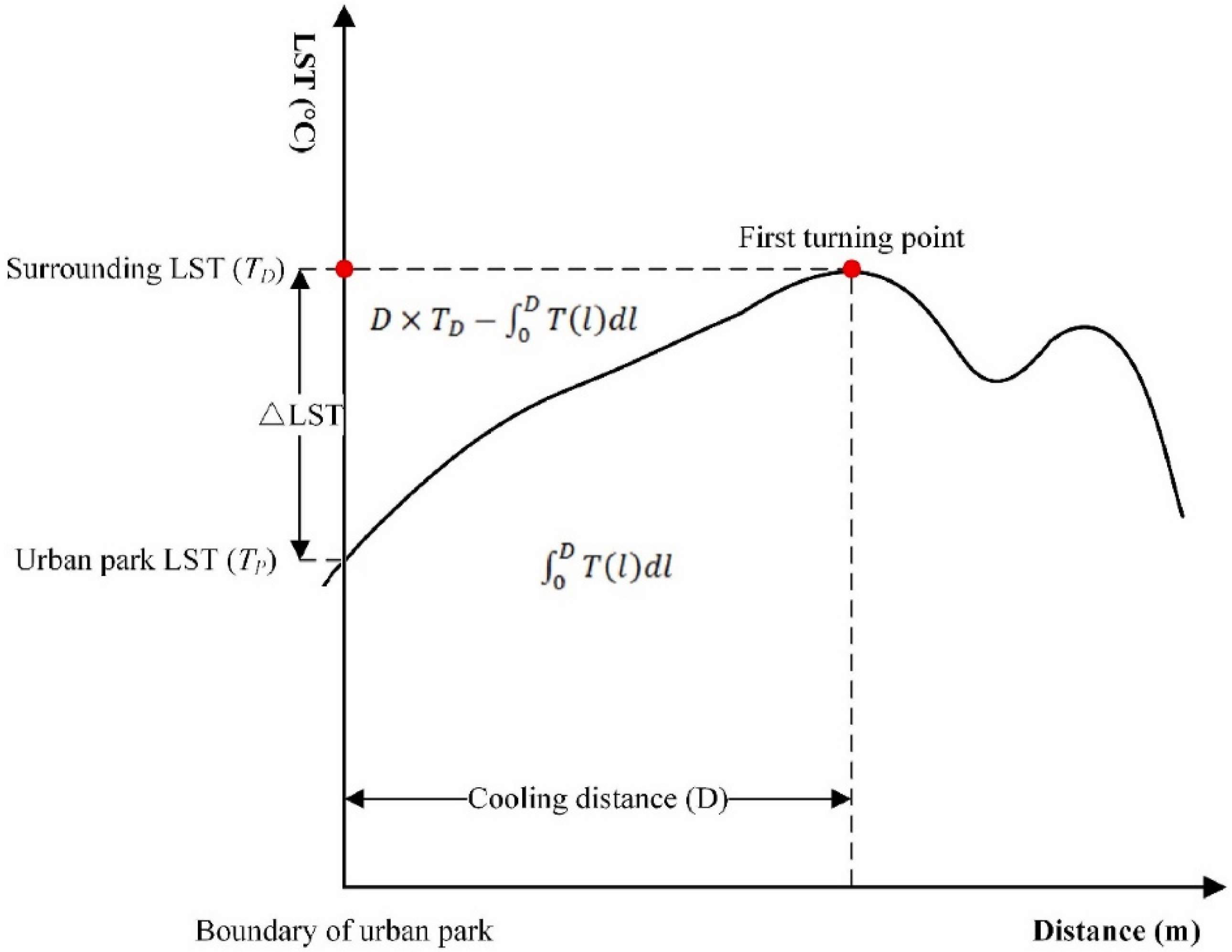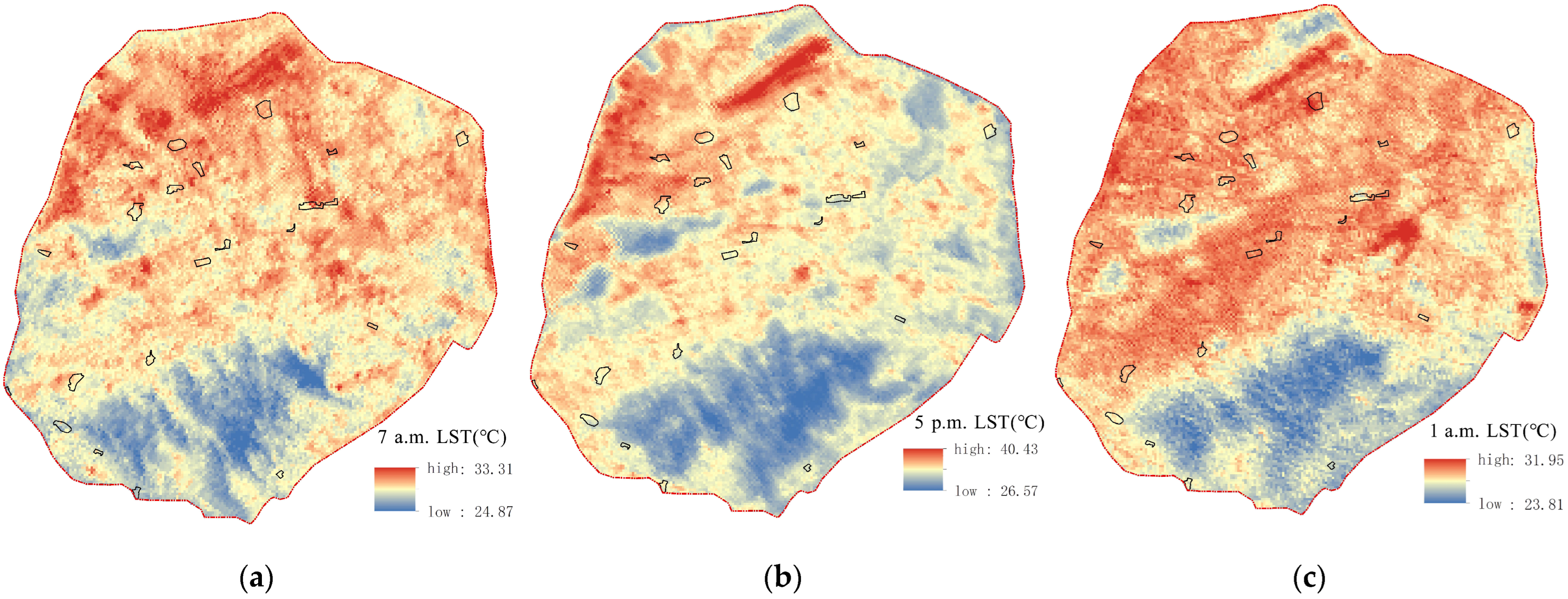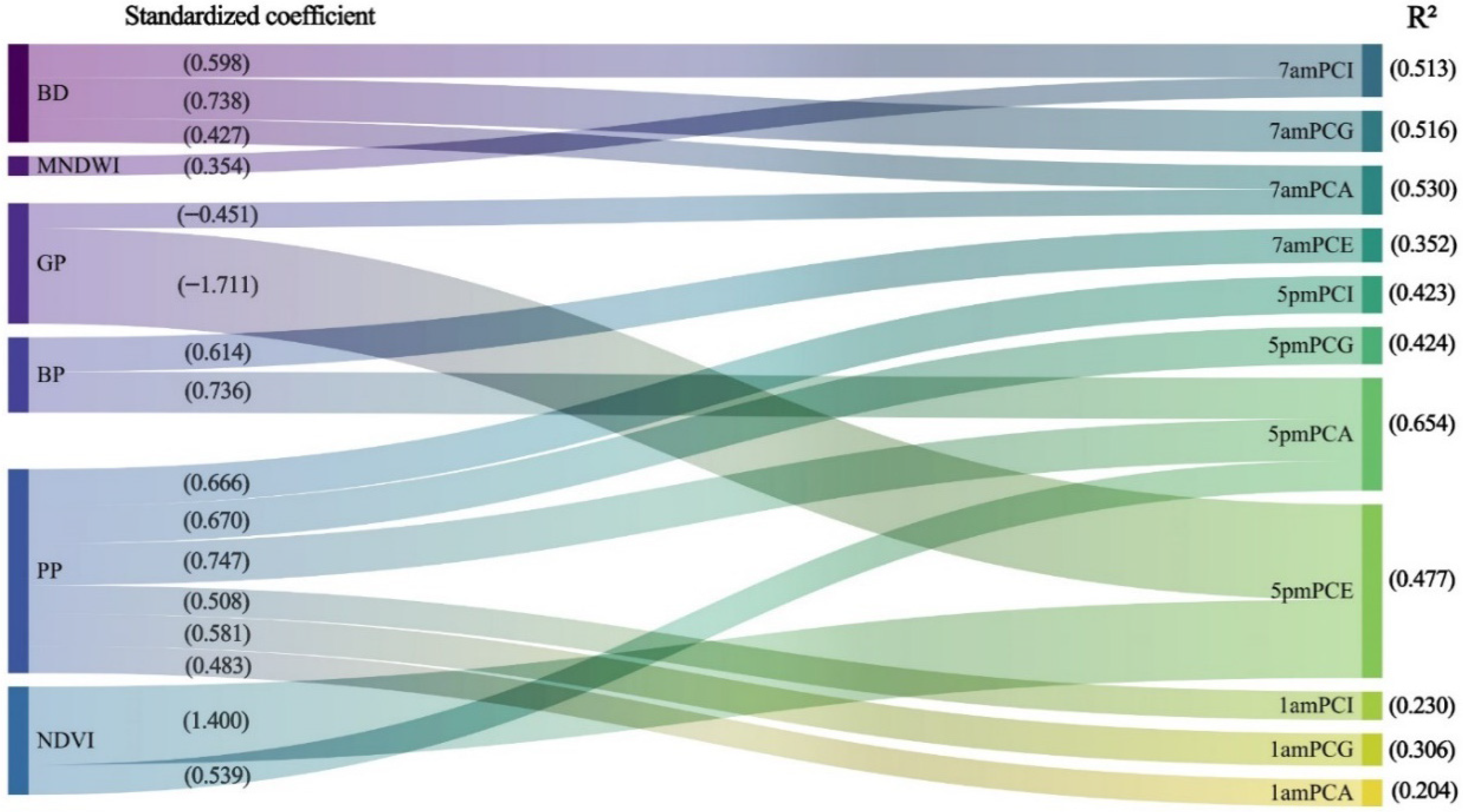Exploring the Diurnal Dynamics Mechanism of the Cold Island Effect in Urban Parks of Island Cities: A Three-Dimensional Spatial Morphology Perspective
Abstract
1. Introduction
2. Study Materials and Methods
2.1. Study Sites
2.2. Data Sources and Processing
2.2.1. Urban Park Data and Selection Criteria
2.2.2. LST Data and Analysis
2.2.3. Urban Morphological Data and Analysis
2.3. Measuring the Park Cold Island Effects
2.4. Factors Influencing the Park Cold Island Effect
2.5. Methods
2.5.1. Analysis of Variance
2.5.2. Correlation Analysis
2.5.3. Stepwise Multiple Regression Analysis
3. Results
3.1. Diurnal Spatial Variation Characteristic of LSTs
3.2. Diurnal Characteristics of PCIE
3.3. Relationship Between PCIE and Urban Morphology
3.4. Diurnal Variations of the Driving Factors of LST
4. Discussion
4.1. Differential Characteristics of PCIE in Island City
4.2. Mechanisms by Which Urban Morphology Influences the PCIE of Parks in Island City
4.3. Planning Strategies for Urban Parks in Island Cities
4.4. Limitations and Prospects
5. Conclusions
Author Contributions
Funding
Institutional Review Board Statement
Informed Consent Statement
Data Availability Statement
Conflicts of Interest
References
- Warsame, A.A.; Abdi, A.H.; Amir, A.Y.; Azman-Saini, W.N.W. Towards sustainable environment in Somalia: The role of conflicts, urbanization, and globalization on environmental degradation and emissions. J. Clean. Prod. 2023, 406, 136856. [Google Scholar] [CrossRef]
- Wen, J.; Mughal, N.; Zhao, J.; Shabbir, M.S.; Niedbała, G.; Jain, V.; Anwar, A. Does globalization matter for environmental degradation? Nexus among energy consumption, economic growth, and carbon dioxide emission. Energy Policy 2021, 153, 112230. [Google Scholar] [CrossRef]
- Rahman, M.M.; Alam, K. Impact of industrialization and non-renewable energy on environmental pollution in Australia: Do renewable energy and financial development play a mitigating role? Renew. Energy 2022, 195, 203–213. [Google Scholar] [CrossRef]
- Zheng, S.; Wang, R.; Mak, T.M.W.; Hsu, S.C.; Tsang, D.C.W. How energy service companies moderate the impact of industrialization and urbanization on carbon emissions in China? Sci. Total Environ. 2021, 751, 141610. [Google Scholar] [CrossRef]
- Anenberg, S.C.; Miller, J.; Henze, D.K.; Minjares, R.; Achakulwisut, P. The global burden of transportation tailpipe emissions on air pollution-related mortality in 2010 and 2015. Environ. Res. Lett. 2019, 14, 94012. [Google Scholar] [CrossRef]
- Doğan Güzel, T.; Alp, K. The effects of technological developments in transportation vehicles on air pollution mitigation of metropolitan cities: A case study of Istanbul. Sci. Total Environ. 2024, 912, 168996. [Google Scholar] [CrossRef] [PubMed]
- Hashim, B.M.; Al Maliki, A.; Sultan, M.A.; Shahid, S.; Yaseen, Z.M. Effect of land use land cover changes on land surface temperature during 1984–2020: A case study of Baghdad city using landsat image. Nat. Hazards 2022, 112, 1223–1246. [Google Scholar] [CrossRef]
- He, T.; Wang, N.; Chen, J.; Wu, F.; Xu, X.; Liu, L.; Han, D.; Sun, Z.; Lu, Y.; Hao, Y.; et al. Direct and indirect impacts of land use/cover change on urban heat environment: A 15-year panel data study across 365 Chinese cities during summer daytime and nighttime. Landsc. Ecol. 2024, 39, 67. [Google Scholar] [CrossRef]
- De Pauw, K.; Depauw, L.; Cousins, S.A.O.; De Lombaerde, E.; Diekmann, M.; Frey, D.; Kwietniowska, K.; Lenoir, J.; Meeussen, C.; Orczewska, A.; et al. The urban heat island accelerates litter decomposition through microclimatic warming in temperate urban forests. Urban Ecosyst. 2024, 27, 909–926. [Google Scholar] [CrossRef]
- Wang, J.; Xiang, Z.; Wang, W.; Chang, W.; Wang, Y. Impacts of strengthened warming by urban heat island on carbon sequestration of urban ecosystems in a subtropical city of China. Urban Ecosyst. 2021, 24, 1165–1177. [Google Scholar] [CrossRef]
- Aznarez, C.; Kumar, S.; Marquez-Torres, A.; Pascual, U.; Baró, F. Ecosystem service mismatches evidence inequalities in urban heat vulnerability. Sci. Total Environ. 2024, 922, 171215. [Google Scholar] [CrossRef]
- Li, T.; Horton, R.M.; Bader, D.A.; Liu, F.; Sun, Q.; Kinney, P.L. Long-term projections of temperature-related mortality risks for ischemic stroke, hemorrhagic stroke, and acute ischemic heart disease under changing climate in Beijing, China. Environ. Int. 2018, 112, 1–9. [Google Scholar] [CrossRef] [PubMed]
- Royé, D.; Zarrabeitia, M.T.; Riancho, J.; Santurtún, A. A time series analysis of the relationship between apparent temperature, air pollutants and ischemic stroke in Madrid, Spain. Environ. Res. 2019, 173, 349–358. [Google Scholar] [CrossRef]
- Guo, H.; Du, P.; Zhang, H.; Zhou, Z.; Zhao, M.; Wang, J.; Shi, X.; Lin, J.; Lan, Y.; Xiao, X.; et al. Time series study on the effects of daily average temperature on the mortality from respiratory diseases and circulatory diseases: A case study in Mianyang City. BMC Public Health 2022, 22, 1001. [Google Scholar] [CrossRef]
- Scheerens, C.; Nurhussien, L.; Aglan, A.; Synn, A.J.; Coull, B.A.; Koutrakis, P.; Rice, M.B. The impact of personal and outdoor temperature exposure during cold and warm seasons on lung function and respiratory symptoms in COPD. ERJ Open Res. 2022, 8, 574–2021. [Google Scholar] [CrossRef] [PubMed]
- Xu, Q.; Zhou, Q.; Chen, J.; Li, T.; Ma, J.; Du, R.; Su, M.; Li, J.; Xu, M.; Sun, S.; et al. The incidence of asthma attributable to temperature variability: An ecological study based on 1990–2019 GBD data. Sci. Total Environ. 2023, 904, 166726. [Google Scholar] [CrossRef] [PubMed]
- Friedman, E.; Solecki, W.; Troxler, T.G.; Paganini, Z. Linking quality of life and climate change adaptation through the use of the macro-adaptation resilience toolkit. Clim. Risk Manag. 2023, 39, 100485. [Google Scholar] [CrossRef]
- Sebestyén, V.; Dörgȍ, G.; Ipkovich, Á.; János, A. Identifying the links among urban climate hazards, mitigation and adaptation actions and sustainability for future resilient cities. Urban Clim. 2023, 49, 101557. [Google Scholar] [CrossRef]
- Liu, O.Y.; Russo, A. Assessing the contribution of urban green spaces in green infrastructure strategy planning for urban ecosystem conditions and services. Sustain. Cities Soc. 2021, 68, 102772. [Google Scholar] [CrossRef]
- Ronchi, S.; Arcidiacono, A.; Pogliani, L. Integrating green infrastructure into spatial planning regulations to improve the performance of urban ecosystems. Insights from an Italian case study. Sustain. Cities Soc. 2020, 53, 101907. [Google Scholar] [CrossRef]
- Huang, R.; Liu, Y.; Liang, S.; Si, J.; Di, S.; Cai, M.; Hu, S.; Hao, C.; Zhao, Z. Social Value of Urban Green Space Based on Visitors’ Perceptions: The Case of the Summer Palace, Beijing, China. Forests 2023, 14, 2192. [Google Scholar] [CrossRef]
- Nasri Roodsari, E.; Hoseini, P. An assessment of the correlation between urban green space supply and socio-economic disparities of Tehran districts—Iran. Environ. Dev. Sustain. 2022, 24, 12867–12882. [Google Scholar] [CrossRef]
- Costadone, L.; Lai, T.; Hurskainen, P.; Kopperoinen, L. Co-creating urban ecosystem accounting: Physical and monetary accounts of runoff retention service provided by urban green spaces. Ecosyst. Serv. 2024, 65, 101576. [Google Scholar] [CrossRef]
- Kim, H.; Shoji, Y.; Tsuge, T.; Aikoh, T.; Kuriyama, K. Understanding recreation demands and visitor characteristics of urban green spaces: A use of the zero-inflated negative binomial model. Urban For. Urban Green. 2021, 65, 127332. [Google Scholar] [CrossRef]
- Zhu, Z.; Li, J.; Chen, Z. Green space equity: Spatial distribution of urban green spaces and correlation with urbanization in Xiamen, China. Environ. Dev. Sustain. 2022, 25, 423–443. [Google Scholar] [CrossRef]
- Zhang, Y.; Murray, A.T.; Turner, B.L. Optimizing green space locations to reduce daytime and nighttime urban heat island effects in Phoenix, Arizona. Landsc. Urban Plan. 2017, 165, 162–171. [Google Scholar] [CrossRef]
- Wang, J.; Zhou, W. More urban greenspace, lower temperature? Moving beyond net change in greenspace. Agric. For. Meteorol. 2022, 322, 109021. [Google Scholar] [CrossRef]
- Fu, J.; Fu, H.; Zhu, C.; Sun, Y.; Cao, H. Assessing the health risk impacts of urban green spaces on air pollution—Evidence from 31 China’s provinces. Ecol. Indic. 2024, 159, 111725. [Google Scholar] [CrossRef]
- Zhang, Y.; Wang, Y.; Ding, N.; Yang, X. Assessing the Contributions of Urban Green Space Indices and Spatial Structure in Mitigating Urban Thermal Environment. Remote Sens. 2023, 15, 2414. [Google Scholar] [CrossRef]
- Yao, X.; Yu, K.; Zeng, X.; Lin, Y.; Ye, B.; Shen, X.; Liu, J. How can urban parks be planned to mitigate urban heat island effect in “Furnace cities”? An accumulation perspective. J. Clean. Prod. 2022, 330, 129852. [Google Scholar] [CrossRef]
- Gangwisch, M.; Saha, S.; Matzarakis, A. Spatial neighborhood analysis linking urban morphology and green infrastructure to atmospheric conditions in Karlsruhe, Germany. Urban Clim. 2023, 51, 101624. [Google Scholar] [CrossRef]
- Baszkiewicz, E.; Wolff, M.; Andersson, E.; Kronenberg, J.; Barton, D.; Haase, D.; Kronenberg, J.; Barton, D.; Haase, D.; Langemeyer, J.; et al. Greenery in urban morphology: A comparative analysis of differences in urban green space accessibility for various urban structures across European cities. Ecol. Soc. 2022, 27, 22. [Google Scholar] [CrossRef]
- Yao, X.; Zhu, Z.; Zhou, X.; Shen, Y.; Shen, X.; Xu, Z. Investigating the effects of urban morphological factors on seasonal land surface temperature in a “Furnace city” from a block perspective. Sustain. Cities Soc. 2022, 86, 104165. [Google Scholar] [CrossRef]
- Zhao, Q.; Li, R.; Cao, K.; Yi, M.; Liu, H. Influence of building spatial patterns on wind environment and air pollution dispersion inside an industrial park based on CFD simulation. Environ. Monit. Assess. 2024, 196, 427. [Google Scholar] [CrossRef]
- Liu, X.; Huang, B.; Li, R.; Zhang, J.; Gou, Q.; Zhou, T.; Huang, Z. Wind environment assessment and planning of urban natural ventilation corridors using GIS: Shenzhen as a case study. Urban Clim. 2022, 42, 101091. [Google Scholar] [CrossRef]
- Guo, A.; Yue, W.; Yang, J.; Li, M.; Xie, P.; He, T.; Zhang, M.; Yu, H. Quantifying the impact of urban ventilation corridors on thermal environment in Chinese megacities. Ecol. Indic. 2023, 156, 111072. [Google Scholar] [CrossRef]
- Shi, Z.; Xu, X.; Jia, G. Urbanization magnified nighttime heat waves in China. Geophys. Res. Lett. 2021, 48, e2021GL093603. [Google Scholar] [CrossRef]
- Wang, J.; Feng, J.; Yan, Z.; Chen, Y. Future Risks of Unprecedented Compound Heat Waves Over Three Vast Urban Agglomerations in China. Earth’s Future 2020, 8, e2020EF001716. [Google Scholar] [CrossRef]
- Santamouris, M.; Cartalis, C.; Synnefa, A.; Kolokotsa, D. On the impact of urban heat island and global warming on the power demand and electricity consumption of buildings—A review. Energy Build. 2015, 98, 119–124. [Google Scholar] [CrossRef]
- Du, Y.; Cui, E.; Tang, S.; Huang, K.; Xia, J. Widespread negative impact of daytime warming on vegetation productivity. One Earth 2025, 8, 101284. [Google Scholar] [CrossRef]
- Yuan, B.; Zhou, L.; Hu, F.; Zhang, Q. Diurnal dynamics of heat exposure in Xi’an: A perspective from local climate zone. Build. Environ. 2022, 222, 109400. [Google Scholar] [CrossRef]
- Wu, J.; Lin, L.; Li, T.; Cheng, Q.; Zhang, C.; Shen, H. Fusing Landsat 8 and Sentinel-2 data for 10-m dense time-series imagery using a degrada-tion-term constrained deep network. Int. J. Appl. Earth Obs. Geoinf. 2022, 108, 102738. [Google Scholar]
- Fisher, J.B.; Lee, B.; Puray, A.J.; Halverson, G.H.; Dohlen, M.B.; Nicholson, K.; Wang, A.; Anderson, R.G.; Aragon, B.; Arain, M.A.; et al. ECOSTRESS: NASA’s Next Generation Mission to Measure Evapotranspiration From the International Space Station. Water Resour. Res. 2020, 56, e2019WR026058. [Google Scholar] [CrossRef]
- Shen, Y.; Zhang, Q.; Liu, Q.; Huang, M.; Yao, X.; Jiang, K.; Ke, M.; Ren, Y.; Zhu, Z. The impact of urban spatial forms on marine cooling effects in mainland and island regions: A case study of Xiamen, China. Sustain. Cities Soc. 2025, 121, 106210. [Google Scholar] [CrossRef]
- Zhu, Z.; Shen, Y.; Fu, W.; Zheng, D.; Huang, P.; Li, J.; Lan, Y.; Chen, Z.; Liu, Q.; Xu, X.; et al. How does 2D and 3D of urban morphology affect the seasonal land surface temperature in Island City? A block-scale perspective. Ecol. Indic. 2023, 150, 110221. [Google Scholar] [CrossRef]
- Wu, Y.; Zhang, T.; Zhang, H.; Pan, T.; Ni, X.; Grydehøj, A.; Zhang, J. Factors influencing the ecological security of island cities: A neighborhood-scale study of Zhoushan Island, China. Sustain. Cities Soc. 2020, 55, 102029. [Google Scholar] [CrossRef]
- Chen, L.; Qi, Q.; Wu, H.; Feng, D.; Zhu, E. Will the landscape composition and socio-economic development of coastal cities have an impact on the marine cooling effect? Sustain. Cities Soc. 2023, 89, 104328. [Google Scholar] [CrossRef]
- Wu, J.; Li, C.; Zhang, X.; Zhao, Y.; Liang, J.; Wang, Z. Seasonal variations and main influencing factors of the water cooling islands effect in Shenzhen. Ecol. Indic. 2020, 117, 106699. [Google Scholar] [CrossRef]
- Liu, C.; Yang, M.; Hou, Y.; Zhao, Y.; Xue, X. Spatiotemporal evolution of island ecological quality under different urban densities: A comparative analysis of Xiamen and Kinmen Islands, southeast China. Ecol. Indic. 2021, 124, 107438. [Google Scholar] [CrossRef]
- Zhu, Z.; Fu, W.; Liu, Q. Correlation between urbanization and ecosystem services in Xiamen, China. Environ. Dev. Sustain. 2020, 23, 101. [Google Scholar] [CrossRef]
- Lin, Z.; Xu, H.; Yao, X.; Yang, C.; Ye, D. How does urban thermal environmental factors impact diurnal cycle of land surface temperature? A multi-dimensional and multi-granularity perspective. Sustain. Cities Soc. 2024, 101, 105190. [Google Scholar] [CrossRef]
- Peng, J.; Dan, Y.; Qiao, R.; Liu, Y.; Dong, J.; Wu, J. How to quantify the cooling effect of urban parks? Linking maximum and accumulation perspectives. Remote Sens. Environ. 2021, 252, 112135. [Google Scholar] [CrossRef]
- Ezimand, K.; Azadbakht, M.; Aghighi, H. Analyzing the effects of 2D and 3D urban structures on LST changes using remotely sensed data. Sustain. Cities Soc. 2021, 74, 103216. [Google Scholar] [CrossRef]
- Luo, P.; Yu, B.; Li, P.; Liang, P.; Zhang, Q.; Yang, L. Understanding the relationship between 2D/3D variables and land surface temperature in plain and mountainous cities: Relative importance and interaction effects. Build. Environ. 2023, 245, 110959. [Google Scholar] [CrossRef]
- Li, J.; Chen, D.; Ou, J.; Rui, Q.; Jin, B.; Zhu, Z.; Ding, G. Exploring the integrating factors and size thresholds affecting cooling effects in urban parks: A diurnal balance perspective. Sustain. Cities Soc. 2025, 126, 106386. [Google Scholar] [CrossRef]
- Wei, Z.; Liu, J.; Gao, X.; Wu, Y.; Liu, Z.; Yao, J. Diurnal variations in cooling effects of urban parks based on ECOSTRESS data: A case study of Beijing. Urban Clim. 2024, 58, 102229. [Google Scholar] [CrossRef]
- Rahaman, S.; Jahangir, S.; Haque, M.S.; Chen, R.; Kumar, P. Spatio-temporal changes of green spaces and their impact on urban environment of Mumbai, India. Environ. Dev. Sustain. 2021, 23, 6481–6501. [Google Scholar] [CrossRef]
- Zhang, J.; Lin, T.; Sun, C.; Lin, M.; Zhan, Y.; Chen, Y.; Ye, H.; Yao, X.; Huang, Y.; Zhang, G.; et al. Long-Term Spatiotemporal Characteristics and Impact Factors of Land Surface Temperature of Inhabited Islands with Different Urbanization Levels. Remote Sens. 2022, 14, 4997. [Google Scholar] [CrossRef]
- Zhou, X.; Okaze, T.; Ren, C.; Cai, M.; Ishida, Y.; Watanabe, H.; Mochida, A. Evaluation of urban heat islands using local climate zones and the influence of sea-land breeze. Sustain. Cities Soc. 2020, 55, 102060. [Google Scholar] [CrossRef]
- Cheung, P.K.; Jim, C.Y. Differential cooling effects of landscape parameters in humid-subtropical urban parks. Landsc. Urban Plan. 2019, 192, 103651. [Google Scholar] [CrossRef]
- Chang, Y.; Xiao, J.; Li, X.; Zhou, D.; Wu, Y. Combining GOES-R and ECOSTRESS land surface temperature data to investigate diurnal variations of surface urban heat island. Sci. Total Environ. 2022, 823, 153652. [Google Scholar] [CrossRef] [PubMed]
- Gunawardena, K.; Wells, M.; Kershaw, T. Utilising green and bluespace to mitigate urban heat island intensity. Sci. Total Environ. 2017, 584–585, 1040–1055. [Google Scholar] [CrossRef]
- Algretawee, H. The effect of graduated urban park size on park cooling island and distance relative to land surface temperature (LST). Urban Clim. 2022, 45, 101255. [Google Scholar] [CrossRef]
- Yu, Z.; Chen, J.; Chen, J.; Zhan, W.; Wang, C.; Ma, W.; Yao, X.; Zhou, S.; Zhu, K.; Sun, R. Enhanced observations from an optimized soil-canopy-photosynthesis and energy flux model revealed evapotranspiration-shading cooling dynamics of urban vegetation during extreme heat. Remote Sens. Environ. 2024, 305, 15. [Google Scholar] [CrossRef]
- Wang, L.; Xu, Y.; Zhai, Y.; Xu, D.; Fang, J.; Yao, Y.; Ren, Z.; Ye, Z. The ideal characteristics of landscape pattern and morphological spatial pattern for seasonal cool island regulation in urban park green space. Urban For. Urban Green. 2025, 107, 128813. [Google Scholar] [CrossRef]
- Wang, X.; Kong, F.; Yin, H.; Xu, H.; Li, J.; Pu, Y. Characteristics of vegetation shading and transpiration cooling effects during hot summer. Acta Ecol. Sin. 2018, 38, 4234–4244. [Google Scholar] [CrossRef]
- Wu, T.; Chen, Z.; Zhou, S.; Huang, R.; Xing, P.; Li, S.; Qiao, R.; Wu, Z. Joint Evaluation of Urban Built Environment’s Driving Patterns on Urban Heat Island (UHI) and Urban Moisture Island (UMI). Sustain. Cities Soc. 2025, 127, 106450. [Google Scholar] [CrossRef]







| Date | Mean Ta (°C) | Mean WS (m/s) | Mean WD (°) |
|---|---|---|---|
| 13 June 2020 | 29.9 | 4.0 | 151.4 (southeast wind) |
| 11 August 2022 | 29.4 | 2.5 | 180.0 (south wind) |
| 25 July 2020 | 29.2 | 2.0 | 178.6 (southeast wind) |
| Factors | Abbreviation | Formula | Parameter Definition and Description | Description |
|---|---|---|---|---|
| 2D factor | ||||
| Park area | PA | -- | -- | The area of urban parks. |
| Park perimeter | PP | -- | -- | The perimeter of urban parks. |
| Green space proportion | GP | The proportion of green space within the buffer zone, representing vegetation coverage intensity. | The proportion of green space in the 700 m buffer zone of the urban park. | |
| Water body proportion | WP | The proportion of water bodies within the buffer zone, representing the intensity of surface water coverage. | The proportion of water body in the 700 m buffer zone of the urban park. | |
| Built-up proportion | BP | The proportion of built-up areas surfaces within the buffer zone, reflecting the extent of built-up areas. | The proportion of built-up in the 700 m buffer zone of the urban park. | |
| Normalized difference vegetation index | NDVI | It indicates vegetation greenness, with higher values representing denser and healthier vegetation. | The mean NDVI in the 700 m buffer zone of the urban park. | |
| Modified normalized difference water body index | MNDWI | It highlights surface water features, with positive values typically indicating open water and negative values representing built-up or vegetated areas. | The mean MNDWI in the 700 m buffer zone of the urban park. | |
| Normalized difference built-up index | NDBI | It indicates the built-up density, with higher values representing more impervious surfaces and a higher degree of urban development. | The mean NDBI in the 700 m buffer zone of the urban park. | |
| 3D factor | ||||
| Building density | BD | Ai represents the footprint area of building i, and BA represents the area of the buffer zone; it indicates the ratio of the building coverage area to the block area. | Building coverage area to block area ratio. | |
| Building height | BH | Hi represents the height of building i, and N represents the number of buildings; it indicates the mean height of buildings within the block. | The mean building height in the block. | |
| Building fluctuation | BF | Hi represents the height of building i, N represents the number of buildings, and represents the mean height of the buildings; it reflects the variability and irregularity of building heights in the vertical dimension of the plot. | The fluctuation height of building standard deviation in the block. | |
| Floor area ratio | FAR | Si represents the total constructed area of buildings, it indicates the ratio of the total building area to the total block area. | The total floor area to the block area ratio. | |
| Sky view factor | SVF | γi represents the vertical angle of elevation for a structure’s horizontal plane, and n represents the number of directions estimated; it indicates the ratio of the visible sky area in specific directions around a point to the total sky area. | The mean sky view factor in the block. |
| Time | Maximum | Minimum | Mean | Standard Deviation |
|---|---|---|---|---|
| 7 a.m. | 27.87 | 30.56 | 29.02 | 0.60 |
| 5 p.m. | 31.37 | 35.53 | 32.95 | 1.09 |
| 1 a.m. | 26.71 | 29.62 | 28.29 | 0.71 |
Disclaimer/Publisher’s Note: The statements, opinions and data contained in all publications are solely those of the individual author(s) and contributor(s) and not of MDPI and/or the editor(s). MDPI and/or the editor(s) disclaim responsibility for any injury to people or property resulting from any ideas, methods, instructions or products referred to in the content. |
© 2025 by the authors. Licensee MDPI, Basel, Switzerland. This article is an open access article distributed under the terms and conditions of the Creative Commons Attribution (CC BY) license (https://creativecommons.org/licenses/by/4.0/).
Share and Cite
Wang, J.; Wu, Y.; Li, J.; Zhu, Z.; Fu, W.; Ding, G.; Xu, X. Exploring the Diurnal Dynamics Mechanism of the Cold Island Effect in Urban Parks of Island Cities: A Three-Dimensional Spatial Morphology Perspective. Atmosphere 2025, 16, 1202. https://doi.org/10.3390/atmos16101202
Wang J, Wu Y, Li J, Zhu Z, Fu W, Ding G, Xu X. Exploring the Diurnal Dynamics Mechanism of the Cold Island Effect in Urban Parks of Island Cities: A Three-Dimensional Spatial Morphology Perspective. Atmosphere. 2025; 16(10):1202. https://doi.org/10.3390/atmos16101202
Chicago/Turabian StyleWang, Jingjing, Yongshu Wu, Junyi Li, Zhipeng Zhu, Weicong Fu, Guochang Ding, and Xiaoling Xu. 2025. "Exploring the Diurnal Dynamics Mechanism of the Cold Island Effect in Urban Parks of Island Cities: A Three-Dimensional Spatial Morphology Perspective" Atmosphere 16, no. 10: 1202. https://doi.org/10.3390/atmos16101202
APA StyleWang, J., Wu, Y., Li, J., Zhu, Z., Fu, W., Ding, G., & Xu, X. (2025). Exploring the Diurnal Dynamics Mechanism of the Cold Island Effect in Urban Parks of Island Cities: A Three-Dimensional Spatial Morphology Perspective. Atmosphere, 16(10), 1202. https://doi.org/10.3390/atmos16101202






